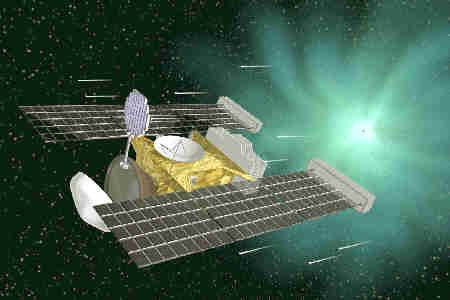by Patrick L. Barry and Dr. Tony Phillips
Philosophers have long sought to "see a world in a grain of sand," as William Blake famously put it. Now scientists are attempting to see the solar system in a grain of dust-comet dust, that is.
If successful, NASA's Stardust probe will be the first ever to carry matter from a comet back to Earth for examination by scientists. It would also be the first time that any material has been deliberately returned to Earth from beyond the orbit of the Moon.
And one wouldn't merely wax poetic to say that in those tiny grains of comet dust, one could find clues to the origin of our world and perhaps to the beginning of life itself.
Comets are like frozen time capsules from the time when our solar system formed. Drifting in the cold outer solar system for billions of years, these asteroid-sized "dirty snowballs" have undergone little change relative to the more dynamic planets. Looking at comets is a bit like studying the bowl of leftover batter to understand how a wedding cake came to be.
Indeed, evidence suggests that comets may have played a role in the emergence of life on our planet. The steady bombardment of the young Earth by icy comets over millions of years could have brought the water that made our brown planet blue. And comets contain complex carbon compounds that might be the building blocks for life.
Launched in 1999, Stardust will rendezvous with comet Wild 2 (pronounced "Vilt" after its Swiss discoverer) on January 2, 2004. As it passes through the cloud of gas and dust escaping from the comet, Stardust will use a material called aerogel to capture grains from the comet as they zip by at 13,000 mph. Aerogel is a foam-like solid so tenuous that it's hardly even there: 99 percent of its volume is just air. The ethereal lightness of aerogel minimizes damage to the grains as they're caught.
Wild 2 orbited the sun beyond Jupiter until 1974, when it was nudged by Jupiter's gravity into a Sun-approaching orbit-within reach of probes from Earth. Since then the comet has passed by the Sun only five times, so its ice and dust ought to be relatively unaltered by solar radiation. Some of this pristine "stuff" will be onboard Stardust when it returns to Earth in 2006, little dusty clues to life's big mysteries.
To learn more about Stardust, see the mission website at stardust.jpl.nasa.gov. Kids can play a fun trivia game about comets at spaceplace.nasa.gov/stardust .
This article was provided by the Jet Propulsion Laboratory, California Institute of Technology, under a contract with the National Aeronautics and Space Administration.

NASA's Stardust mission will capture dust from comet Wild 2 and bring them back to Earth for study.

